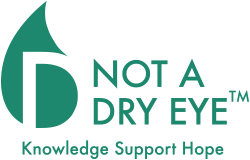Finding a cure is something many Dry Eye patients wish for. That’s why whenever a new study promising remarkable results is published it’s hard not to get excited.
This, we hope, will be the treatment that will cure me once and for all.
But all too often the excitement is short-lived. We may find a doctor who provides the revolutionary new treatment (or diagnosis). But when our symptoms don’t improve it can be disappointing. Eventually, our faith in the entire medical profession may erode. We may even lose hope of ever finding relief.

Unfortunately, it’s easy enough for researchers to make all sorts of claims. They often have a vested interest in the study’s success. Either it’s to continue funding for their research projects or because there’s money to be made when a product is commercialized. (Sometimes enormous amounts of money, but not always).
Sometimes the claims are truthful and accurate. But sometime not so much.
That’s why it’s up to each of us, individually, to learn how to read between the drops and become a discerning consumer of medical research.
But where should you begin? Today, and in upcoming blogs, we’ll provide food for thought and other tips that can help with reading between the drops.
Question 1 – Does the Hypothesis Make Sense?
One of the biggest challenges for Dry Eye patients is simply figuring out what makes sense and what doesn’t. Most of us aren’t trained researchers or scientists. We’re not familiar with the anatomy of the eye or the eye lid. We’ve never observed the formation of tear film up close, even though we may have heard about its three arguably distinct layers.
How does a meibomian gland actually produce meibum?What does the inside of lacrimal gland look like and how does it secrete? As patients we’re mostly in the dark here.
This lack of knowledge puts us at a distinct disadvantage. Anyone can tell us just about anything and who are we to argue?
Well, we’re patients. These are our eyes and our lives. So let’s not be afraid to challenge medicine. Let’s go ahead and ask those hard question. One good place to begin is at the beginning, the researcher’s original hypothesis a.k.a. assumption.
All Research Starts With a Hypothesis
All research studies start with a hypothesis. They end with a conclusion. In between is where the research happens.
But what happens if the hypothesis is wrong? Won’t the research be flawed? What about the conclusion. Won’t that be totally off base too?
The answer to all of these is probably yes.
In Dry Eye care, all too often, an erroneous hypothesis is the source of treatments that don’t really work (complicated by the many different co-morbidities that Dry Eye patients face, no doubt).
So when you read the summary, or reporter’s account, of any Dry Eye study, ask yourself first, does the underlying hypothesis make sense?
For example, let’s consider the assumption that Dry Eye pain is psychosomatic or caused by neuropathy.
Ask yourself, does that make sense? Maybe it does.
But does it also make sense that a part of the body that has 300 to 600 times more nerves than any other part of the body doesn’t feel something that can cause pain? Why not?
With such a high concentration of nerves, isn’t it more likely that your eyes are able to detect a miniscule defect that your doctor can’t, or doesn’t know how to, detect? (Incidentally, applying Occam’s razor here might lead to the same conclusion).
So question the hypothesis. If the hypothesis doesn’t make sense, maybe it’s time to look for answers somewhere else.
Question 2 – Does the Experiment Make Sense?
Sometimes studies really do cause us to question the medical profession. Or at least the medical research profession. Take this one.
A recent study suggested that mistletoe extract combined with carboxymethyl cellulose eye drops was an effective treatment for Dry Eye.
So far so good.
But the control – what the mistletoe drop was compared to – was saline drops.
That’s where the study, in our opinion, fell apart. In fact, it left us utterly bewildered. (Nevertheless, it was reported by a reputable source. More on that in future posts).

Back to the study at hand. Let’s examine it in detail.
Mistletoe extract was added to a lubricating eye drop containing carboxymethyl cellulose. The lubricating drop itself is a treatment for Dry Eye. This combination of mistletoe in a lubricating drop was compared to saline drops (of unspecified concentration), something that’s not a treatment for Dry Eye. (Sterile 0.9% saline is sometimes used to flush out eyes. But it’s not used as a replacement for tear film or as a lubricating agent. Let us stress again, sterile saline is not, and should never be, considered a treatment for Dry Eye).
Reading Between the Drops
Despite this puzzling comparison, the researchers concluded that mistletoe was an effective treatment for Dry Eye because patients felt better after using the mistletoe/lubricating drop combination and worse after using the saline drop.
What?
Why didn’t the researchers compare the mistletoe/lubricating drop compound to a “virgin” lubricating drop? Or to nothing? (This is what we mean by reading between the drops).
Only they can answer that question.
But at least their study confirmed that saline drops shouldn’t be used as a treatment for Dry Eye, although they never really said so.
It’s this kind of thing that leaves us completely and utterly puzzled while wondering, why are these scientists conducting such a poorly designed experiment (and who are the editors who let something like this get published?)
So feel free to question researchers and their experiments. And if they prove to be nutty, then go ahead, by all means, lose faith them.
And who knows. Maybe mistletoe extract really will be the next new thing in Dry Eye treatment. But it’s going to take a better designed study to prove it.
Next Time
There’s a lot more to consider when it comes to Dry Eye research or any medical research for that matter. In upcoming posts we’ll be looking at other ways that can help when you’re reading between the drops.
Reference
Effect of mistletoe combined with carboxymethyl cellulose on dry eye in postmenopausal women
Nan Jiang, Lin-Hong Ye, Lei Ye, Jing Yu, Qi-Chen Yang, Qing Yuan, Pei-Wen Zhu, and Yi Shao
International journal of ophthalmology
2017; 10(11): 1669–1677
Published online 2017 Nov 18. doi: 10.18240/ijo.2017.11.06
View the full report
Send your questions and comments to blogger@notadryeye.org.
Subscribe to our blog to keep up with Not A Dry Eye. It’s FREE!
Support Not A Dry Eye Foundation. When you shop at smile.amazon.com, Amazon donates 0.5% of your purchase at no additional cost to you.


